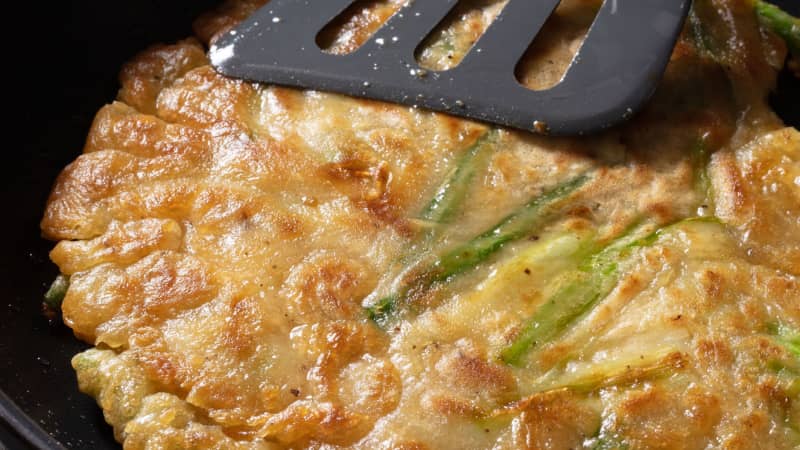Koreans have never needed a good excuse to eat pajeon, but everyone seems to have one. Most notably: rain.
Pajeon: Recipe for a Rainy Day
Published Mar. 30, 2021.

“Whenever it’s a rainy day, people say, ‘Oh, this is time to eat pajeon and makgeolli,’” Nanam Myszka said of the cuisine’s ubiquitous scallion pancake. “My mom will say it, my grandma will say it.”
Myszka, who grew up in Seoul and now co-owns Epiphany Farms Hospitality Group with her husband, Ken, in Bloomington, Illinois, said that the association is about sound: The sputter and sizzle of the pajeon batter crisping in oil echoes the light, rhythmic tapping of rainfall—and in a part of the world that experiences significant precipitation, the response is downright Pavlovian. Sales of pancake ingredients and makgeolli, the so-called farmer’s liquor made from fermented rice, reportedly surge, and crowds flood local pajeon shops.
There are other inclement weather–related associations, too, such as the theory that flour-based foods boost serotonin and blood sugar during gloomy low-pressure spells, and the popular tale of Korean farmers who fried up jeon (a broader term for battered and pan-fried foods) when it was too rainy to work in the fields. The ingredients were accessible, and the crispy, glutinously chewy food was just the thing to eat with cheap, milky makgeolli.
But above all, jeon taps into two fundamentals of Korean cooking: community and resourcefulness. It’s celebratory fare that goes into the middle of the table, surrounded by—as Seoul-based chef Won Chung described—“glasses full of makgeolli and chopsticks fighting over the crispy bits.” It’s also a catch-all preparation that accommodates whatever vegetables and proteins cooks have on hand.
“In many ways, it’s a leftover dish,” said Bill Kim, a Seoul native and chef-owner of the acclaimed Chicago restaurant Urbanbelly. “You have the batter, and whatever you have, or whatever you could afford, you make it into a pancake.”
Kim values those principles as much as any pragmatic-minded cook, but for him, making and eating pajeon is even more about family. Almost every Saturday morning, he drives to his parents’ condo in Vernon Hills, Illinois, to have breakfast with them—a ritual they started a few years ago as a way to reconnect. A haemul (seafood) pajeon, the pancake loaded up with scallions and either squid or octopus, is the first thing they eat.
“One hundred percent of the time we have to have it right off the frying pan with soy sauce, vinegar, and sugar sauce,” he said.
What makes the tradition so meaningful for him is that his mother—“the real chef in the family,” according to Kim, and the one who does all the cooking at home—goes out of her way to make sure that the pajeon is hot and crisp when he gets there.
“I have to call her 15 minutes ahead,” he said. “When I get off the highway, she starts making it. She doesn’t want to let it sit.”

